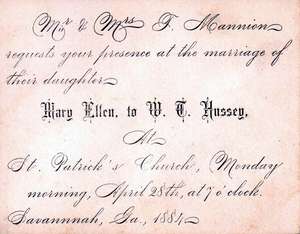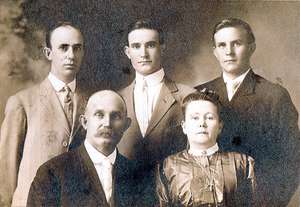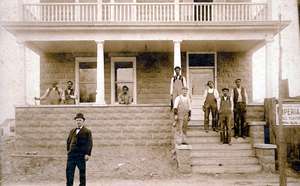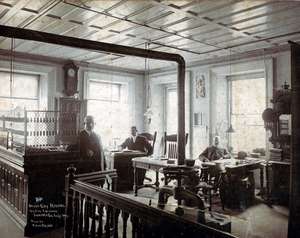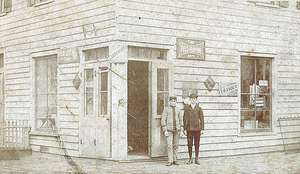William T. Hussey
First in Savannah
W.T. was a small child during the Civil War and life must have been very hard during his formative years with the South in a deep recession. His birth family was said to be an unhappy one with an overbearing mother and seven bothers and sisters. Just when things looked like they couldn't get any worse, what came to be known as the Panic of 1873 occurred and plunged the nation into a recession that would last for the remainder of the 1870's.
Around 1880 W.T.'s fortunes rubbed up against those of soon to be railroad tycoon Henry Plant. Henry Plant had already built a sterling reputation in the railroad business and was a key figure in the success of what would later come to be known as the Railway Express Company. On November 4,1879 Plant purchased the Atlantic & Gulf line at a foreclosure sale in Savannah for $300,000. He reorganized the line as the Savannah, Florida and Western Railway and it's 237 miles of track between Savannah and Bainbridge, Georgia became the keystone of what would become the Plant System.
After his father death, W.T. signed over his inheritance to his bother and sisters and moved to Savannah in the early 1880's to work for the Savannah, Florida and Western Railroad. He worked as a carpenter and may have built and maintained depots and other facilities throughout the growing system of Plant railroads. The nature of railroad work required employees to be away from home for extended periods and when they returned they would have several days off without pay. On these off days, W.T. worked construction for local contractors. A few years later, he changed positions and became a Car Builder in the Plant System railyards in Savannah. He built new cars as well as maintained existing rolling stock which other than the undercarriage were primarially made of wood.
The Plant System railroads grew and prospered. They would eventually encompass almost 2000 miles of track along the eastern seaboard stretching from Richmond, Virginia to Tampa, Florida and west to Birmingham, Alabama and Atlanta, Georgia. When Henry Plant died in 1899, despite his expressed intent, his heirs began to breakup Plant Systems and sell off the lines.
In 1902 after 20 years of railroad work, W.T. resigned and accepted a position as Deputy City Marshal of Savannah working for his friend the then City Marshall Henry Dreeson. Also in 1902, W.T. bought a grocery store located at 1402 Habersham from F. Rohr. Mary ran this store until late 1903, when they sold the Habersham store and bought a larger grocery at 1118-20 Lincoln which included an apartment in which they resided. This was short lived, as in 1905 they relocated the grocery to 325 31st Street. They lived in a house next door at 323 31st.
1907 brought political change, City Marshall Dreeson cronies were not reelected, therefore W.T. was no longer the Deputy City Marshal. However, Savannah was growing fast, spurred on by the availability of mortgages from Savings and Loan institutions, the availability of municipal water outside the downtown area and the expansion of street car routes to the suburbs. The building business was booming. In 1908 W.T. formed a partnership with Frank Steinacker and entered the General Contracting business as Steinacker & Hussey. The building business was good and W.T. and Mary sold their grocery business. Even so, less than 2 years later Frank and W.T. dissolved their partnership and each continued on as independent builders and contractors.
In 1909, W.T. built a large 2 story stone house for his old friend Henry Deason on the corner of Barnard and 39th. In the same year he started construction of a white 2 story Victorian house with a wrap around porch at 907 Waldburg Street. Always a forward looking builder and progressive man of his day, W.T. became the 138th customer of the fledgling Savannah Telephone Company which had come into being only 3 years earlier. Likewise the house on Waldburg Street was built with both gas and electric light fixtures, as the generation of electricity was not as reliable as it would later become. The house had marble floors downstairs and featured stained glass windows and stained glass transom lights. W.T. and Mary would live out the rest of their lives in the house on Waldburg Street.
Henry Dreeson was appointed to the Chairmanship of the Chatham County Board of Tax Assessors in 1918. W.T. continued his contracting business but also took on the additional role of a County Tax Equalizer. In 1921 he became a member of the Board of Tax Assessors for Chatham County, a position he would hold until his death in 1927.
1920 saw the creation of a new Catholic parish in which W.T. and his family lived and were members. He was general contractor for the new Blessed Sacrament church. It was a white frame structure, with a seating capacity of 200, which was erected at a cost of $9,867. The interior was of Flemish oak. Two rows of pews, separated by a center aisle, were finished in dark green, and had a wooden crucifix at the head of each pew. A small white altar graced the sanctuary. Radiators provided steam heat for the building. There was a choir loft at the rear, and music was supplied by a pump organ. The first Mass was celebrated on May 21, 1921.
W.T. was a member of the Independent Order of Beavers, Savannah Dam No. 12 I.O.B. He was also a member of the Benevolent and Protective Order of Elks who performed a special ceremony at his funeral.
Photographs & Documents
Click an image to view larger
